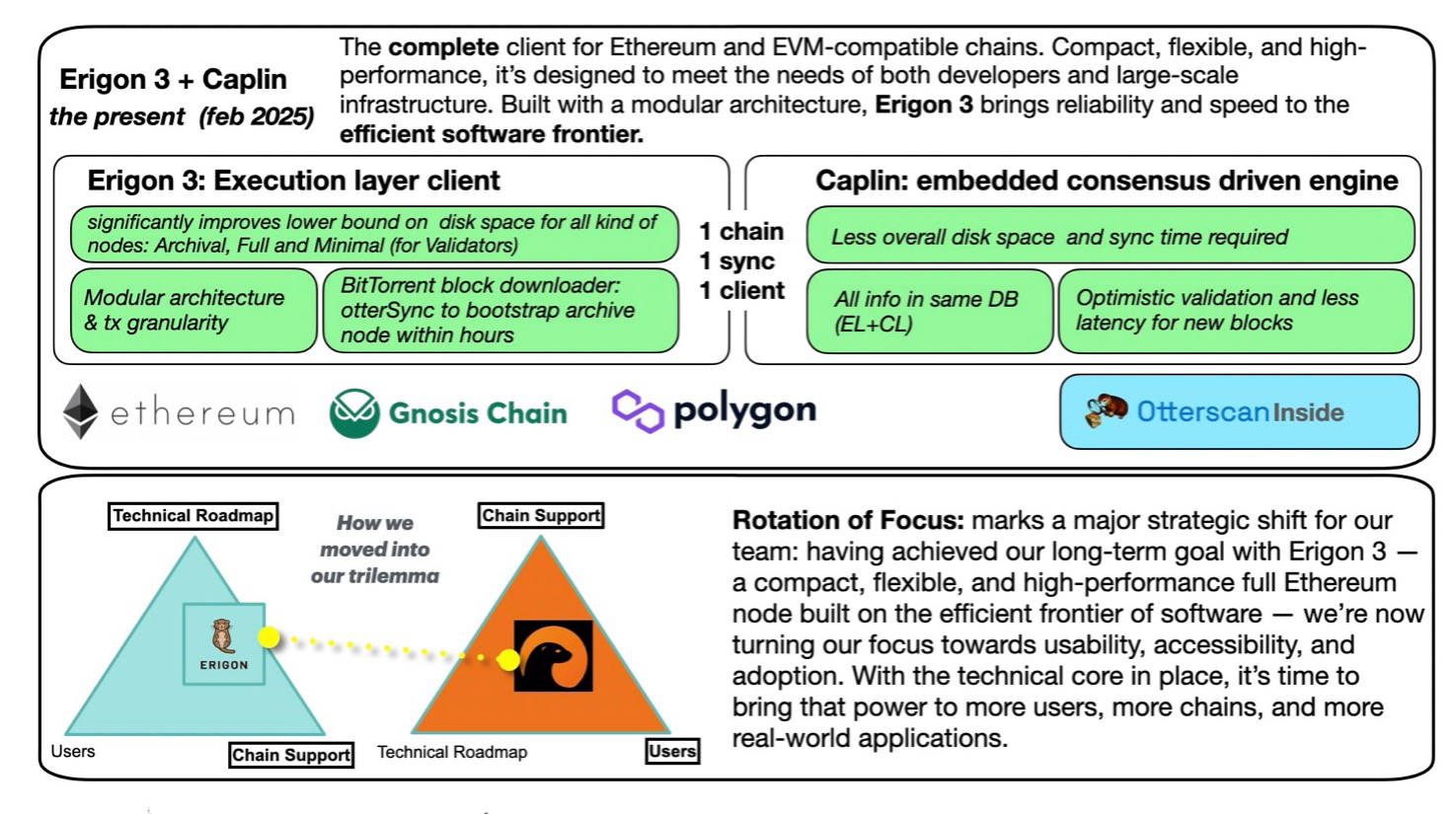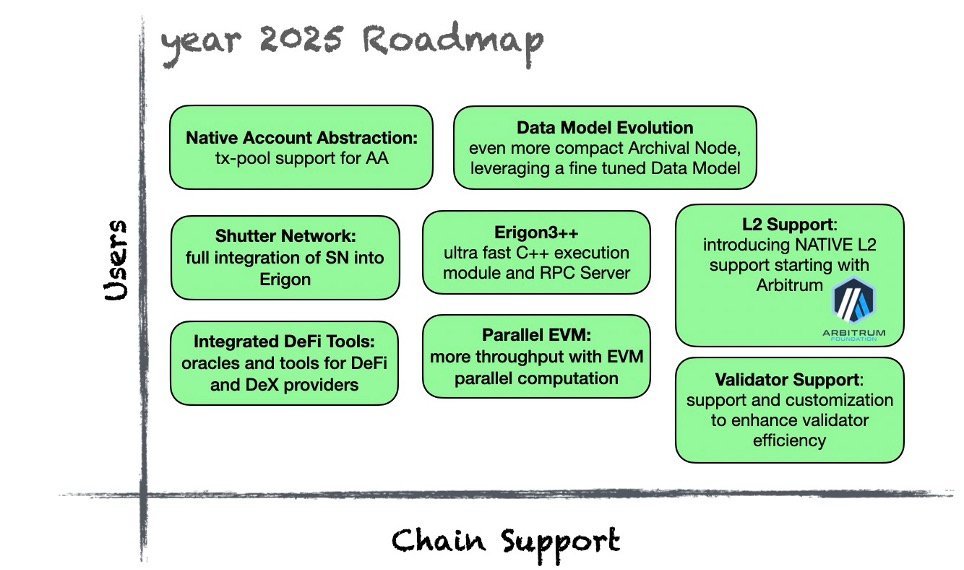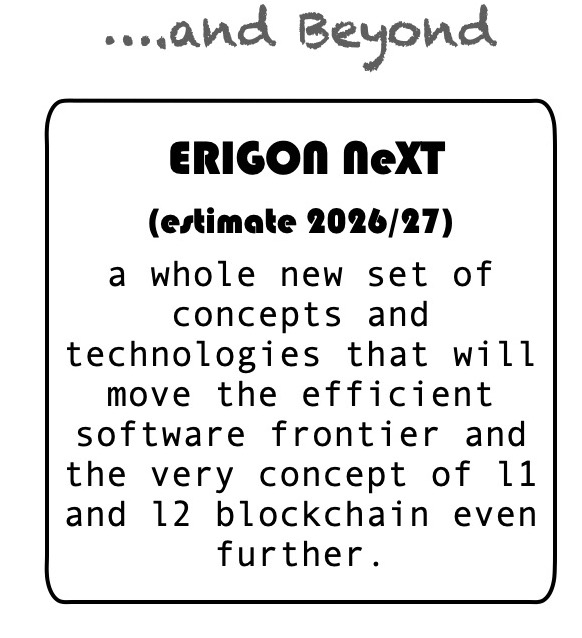Rotation of focus
2025 marks a turning point for Erigon. After years of continuous development, the team has completed one of the most ambitious phases of the project: the creation of a complete, flexible, and high-performance Ethereum client. With Erigon 3 and Caplin, the vision of a compact, modular, and efficient blockchain infrastructure fully takes shape, paving the way for a new phase focused on adoption and scalability.

At the core of this new version lies a clear focus on operational efficiency. Erigon 3 has been designed to operate at the efficient frontier of software, delivering optimal performance across all key configurations — whether as an archival node, a full node, or a minimal validator node. Its updated architecture integrates both the Execution and Consensus Layers within a single database, offering significant advantages in terms of disk space, sync times, and ease of operation. The Caplin consensus engine, fully embedded within the client, enables optimistic block validation, reducing latency and improving overall responsiveness.
Yet the shift is not purely technical. 2025 also marks a strategic transition: having reached infrastructure maturity, Erigon is now turning its attention towards accessibility, user experience, and real-world adoption. The goal is no longer just to build efficient software, but to place it in the hands of those who can truly benefit from it — developers, network operators, DeFi providers, communities, and emerging chains.
The Roadmap in Details
Now let’s look at the features and innovations we want to see in 2025:

L2 support:
Erigon 3 is designed with Layer 2 compatibility in mind. Its modular architecture makes it ideal as a high-performance data backend for rollups and zk-based chains. We’re starting an active collaboration with Arbitrum to deliver fast access to state data, stable APIs, and efficient indexing. Our goal is to simplify node operations and enhance developer experience across the L2 ecosystem.
Validator Support:
Erigon 3 provides native support for validators by combining Execution and Consensus Layers into a single, high-performance client. The integration with Caplin simplifies validation workflows and reduces latency. We also plan to actively collaborate with staking pools and liquid staking providers to further enhance Erigon’s validation capabilities, ensuring efficiency, reliability, and ease of use at any scale.
Erigon 3++ :
introduces high-performance execution module and RPC server written in C++20, designed to push the boundaries of speed and responsiveness. By decoupling critical execution paths from Go and reimplementing them in optimized C++20 code, Erigon3++ significantly reduces latency for transaction processing, state access, and RPC calls. This architecture enables faster response times under load and considerably improves scalability for high-throughput applications. The new RPC server is fully compatible with standard Ethereum interfaces, while offering fine-grained control over concurrency, memory usage, and resource isolation — making Erigon 3++ ideal for power users, infrastructure providers, and latency-sensitive deployments.
Full Shutter Network Integration:
Erigon is integrating Shutter Network natively to bring encrypted mempool capabilities directly into the client. This integration enables frontrunning protection and preserves transaction privacy until block inclusion, without relying on external relayers. By embedding threshold encryption at the protocol level, Erigon strengthens Ethereum’s resistance to MEV and opens the door to more fair and secure transaction ordering.
Parallel EVM:
Parallel execution is set to become a core component of Erigon’s future performance model. The current EVM processes transactions sequentially, ensuring deterministic state transitions but limiting throughput. Parallelism introduces a more advanced execution model where non-conflicting transactions can be executed concurrently within a single block.
This requires dynamic dependency detection and safe scheduling mechanisms to avoid state conflicts and preserve consensus guarantees. By leveraging thread-level parallelism, erigon will be able to better utilize modern multicore processors, unlocking significantly higher transaction throughput without altering the network’s core security model.
Parallel execution won’t just improve VM performance it will help with the optimization of commitment calculations. It will also move the efficiency frontier of on-chain computation, by enabling pipelined indexers to operate on spare processor threads alongside block generation.
Native AA:
Erigon is preparing for native Account Abstraction by adapting its modular txpool. Unlike monolithic designs, Erigon’s separable txpool can be extended to handle user operations with custom validation logic. This makes it well-suited for scaling Account Abstraction in the public mempool, enabling programmable wallets, flexible fee models, and new UX paradigms — all while maintaining performance and compatibility with legacy transactions.
With further development, it may even be possible to run multiple txpools connected to a single Erigon instance. This modularity allows for greater control over how transactions are validated, prioritized, and propagated — a crucial capability for supporting Account Abstraction at scale.
Integrated DeFi Tools:
Erigon 3 will offer native integration of DeFi-oriented tooling, including oracle support and data services tailored for DeFi and decentralized exchange providers. By exposing stable, low-latency access to historical and real-time on-chain data directly from the client, Erigon reduces the need for external indexing layers. This architecture enables more robust price feeds, efficient event monitoring, and faster settlement logic within trustless environments.
Data Model Evolution:
Erigon 3 introduces a significantly evolved data model designed to further reduce storage requirements and improve access patterns — especially for archival nodes. By fine-tuning how historical state, receipts, and traces are encoded and stored, the new model enables even more compact archival nodes without compromising data integrity or query speed.
One more Thing: Erigon NeXT
Erigon NeXT (est. 2026/27) will not be a simple continuation of what has been done so far. It will represent a quantum leap in blockchain software design. If the first version of Erigon, then known as Turbogeth, redefined what it means to build an efficient, modular, high-performance Ethereum client, Erigon NeXT aims to go beyond the very limits of what we currently consider a “client.” It will build upon and extend the innovations introduced throughout Erigon’s journey: parallel execution, unified databases, a composable architecture, and advanced support for validators and Layer 2 systems.

But the ambition goes far beyond incremental improvement. With Erigon NeXT, we aim to explore new technical and conceptual foundations to address current limitations in scalability, interoperability, and operational complexity in a more systemic way. The goal is to challenge the conventional separation between Layer 1 and Layer 2 and to build an infrastructure where execution and validation layers are more tightly integrated and coordinated.
Although the project is still in its early stages, the direction is already clear. The design choices behind Erigon NeXT are informed by the experience gained through the evolution of the Erigon client and by continuous dialogue with our official partners. The real-world needs of infrastructure providers, validator operators, and large-scale developers have offered us valuable insight: reduce operational complexity, increase architectural coherence, and provide a robust technical foundation capable of supporting the emerging use cases of the coming years. Erigon NeXT will not just be faster or more modular — it will be built to natively address the challenges the industry is already beginning to face.

